[Front Page] [Features] [Departments] [SGAP Home Page] [Subscribe]

Short Cuts
Readers are invited to submit short items of interest about Australian plants to be included here. If submitting non-original material (eg newspaper or magazine cuttings), please also advise if the author has given permission to republish and, if not, please provide a contact address so that permission can be sought.
Short Cuts in this issue:
 Nomenclature - Order or Chaos? Nomenclature - Order or Chaos?
- Confused by plant names? There is method here.....really!
 Around the "S" Bend Around the "S" Bend
- A lot of fuss over the letter "s"? Perhaps, but rules are rules.
 Growing plants from seed - Viability and Dormancy Growing plants from seed - Viability and Dormancy
- Germination of some seeds is unreliable. Why is that?
 Getting the priorities right Getting the priorities right
- What do a legless lizard and a long-tailed greenhood have in common?
 A plant of geographical oddity A plant of geographical oddity
- Hakea trineura grows in two widely separated locations
 Growing Grass Trees Growing Grass Trees
- Do Xanthorrhoea species deserve their reputation for slow growth?
 
Nomenclature - Order or Chaos?
Bill Gunn sorts through the confusion of botanical names....families, genera, species and all those other mysterious terms. They're not as difficult to understand as you may think!!
It proves impossible in writing on nomenclature not to refer to classification as the two are so closely interwoven, nomenclature being dependent on classification. The intention here it to use the Angiosperms as the example source. These are the plants which produce flowers and seeds. The other intention is to keep things reasonably simple.
Family: How does a plant earn its name? The Angiosperms are divided into monocotyledons and dicotyledons. These two very large groups are first divided into families. Each family contains plants which are sufficiently similar in reproductive systems to suggest that they have developed form a common ancestor, eg the monocot, Orchidaceae, or the dicot, Epacridaceae.
The family name always starts with a capital letter and ends in 'eae' and most often in 'aceae'.
Genus: The families are divided into genera (the singular is 'genus'). These consist of groups of plants with sufficient botanical similarity to be classified as a genus, eg Pterostylis (Orchidaceae) and Epacris (Epacridaceae). Within a family there may be tribes. These are closely related but different genera.
As with the family, the genus name always starts with a capital letter - hence Pterostylis and Epacris.
Species: The genera are then divided into species, each species having sufficient botanical variation to enable it to be distinguished from other species in the same genus, eg Pterostylis nutans and Pterostylis nana or Epacris microphylla and Epacris impressa. Often the species name describes a botanical feature of the plant; eg nutans means 'nodding' and microphylla means 'having very small leaves'.
A plant name always consists of two words: first the genus with its capital letter, then a word to define which species - this second word always starts with a small letter and botanists call it the 'specific epithet'. The convention is to have genus and species names printed in italics.
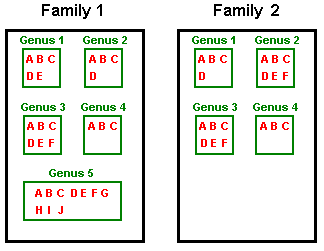 
A Diagrammatic Representation of Plant Classification.
Family 1 consists of 5 genera with genera 1 to 5 having 5, 4, 6, 3 and 10 species, respectively;
Family 2 consists of 4 genera with genera 1 to 4 having 4, 6, 6, and 3 species, respectively.
Diagram based on material in the newsletter of the Tasmanian Region of SGAP, June 1987.
Subspecies and others: Some species (abbreviated to sp. for singular and spp. for plural) may be divided into subspecies (ssp.), varieties (var.) or forms where differences are not significant. Some botanists may not recognise varieties or forms because the differences are so small.
Subspecies and varieties have small letters and are printed in italics.
In the case of cultivars (horticultural varieties of plants), cultivar names start with capital letters; they are not printed in italics and they are enclosed in single quotation marks, eg Correa 'Marian's Marvel'.
The species name may be very useful to us in identifying a plant. If a species name ends in -flora we know that this refers to a feature of the flower, eg grandiflora tells us that the flower will be large. If the species name ends in -folia or -phylla we know that it refers to the foliage, eg microphylla tells us that the leaves will be very small.
However, some botanists have not been too helpful. They or others have given plants a species name based on their own names, eg Epacris gunnii, so named after Ronald Gunn, the 19th century botanist, and little help in identification by the appearance of the plant.
To help us understand nomenclature and use it to our advantage, it helps to become familiar with regularly used botanical terms and their meanings. Excellent assistance can be obtained from the translation of species names in the Encyclopaedia of Australian Plants by Elliot and Jones and from the glossaries in such publications as Australian Plants Identified by Glen Elliot, The Language of Botany by C.Debenham and Name that Flower by Clarke and Lee.
As a result of the work of the taxonomists, those very busy people, classification and, therefore, nomenclature changes are always continually taking place, some long overdue and some causing us to wonder a little. However, there must be order in the system so that, world wide, every plant has but one botanical name and so can be positively identified.
Common names can often be confusing. Take "prickly Moses" for example. In Victoria it is Acacia verticillata, in Western Australia it is Acacia pulchella and in New South Wales it is Acacia ulicifolia. Not at all helpful.
The alternative to an ordered system of nomenclature is chaos, so bear with the taxonomists, the classifiers and others involved.
From the September 1995 issue of the newsletter of the Victorian Region of SGAP.
[ Return to Index ]

Around the "S" Bend
Is it Brachycome or BrachyScome? It seems a simple question but the answer is far from simple. Will the "s" supporters triumph or will the "s" be eradicated?? Brian Walters investigates....
It's not an answer that will rock the foundations of society, but why do some authors use the spelling "Brachycome" while others use "Brachyscome"? The variation occurs too frequently to be blamed on poor proof reading. A recent discussion on the matter in one of the Society's newsletters spurred Judy Barker, leader of the Australian Daisy Study Group, to send me a copy of the abstract to the paper "Two new species of Brachyscome Cass. (Compositae: Asteraceae), with a note on the orthography of the generic name" by Dr Phillip Short of the National Herbarium of Victoria. Dr Short has been working on a revision of the genus Brachyscome for some years and his opinion can be regarded as authoritative.
The situation is a bit complex and some might consider that this is a lot of fuss over a single letter. As you will see, however, it’s a letter with a considerable history......
According to Dr Short, the sequence of events is as follows:
- 1816: Cassini created the generic name Brachyscome
- 1824: Cassini considered his original spelling erroneous and changed it to Brachycome (no "s").
- 1948: Davis recognised that the original spelling should have priority but that to alter the terminology of the whole group by not accepting Cassini’s later correction would be pressing the law of priority to ridiculous lengths.
- 1954: A proposal to conserve the spelling Brachycome was put to the Special Committee for Pteridophyta and Phanerogamae (the accepted Authority) . The proposal was defeated but there was no clear resolution of the preferred spelling.
- 1965: Eichler considered that there was no reason to consider the original spelling to be in error and that Cassini’s alteration was not in accordance with the International Code of Botanical Nomenclature (ICBN).
- 1981: The spelling Brachycome was used in Volume 1 of the "Flora of Australia", but this was an arbitrary decision made in light of the uncertainty regarding the correct spelling.
As a result of this and other evidence, Dr Short concludes that "....to be in accordance with the rulings of the ICBN, the original spelling, Brachyscome, should be adopted".
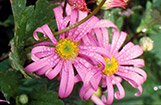 |
The colourful flowers of Brachyscome formosa are a spectacular addition to gardens in Mediterranean climates. Select the thumbnail image or plant name for a higher resolution image (39k).
|
So, there it is. Henceforth this publication will pursue a relentless programme to reinstate the "s" to its rightful status. Dissension will not be tolerated! Recalcitrants will be violated!!
.....now, can we do something similar with BrachySchiton?
[ Return to Index ]

Growing Plants from Seed - Viability and Dormancy
Alf Salkin investigates the mechanisms that frustrate our attempts to successfully grow some species.
Having failed on many occasions to grow plants from seed, I know well the feeling of "post mortems". Was the medium well drained enough? Did I plant the seed too deep or too shallow? Should I have given the seed pre-treatment?
If we know some of the many reasons why seeds do not grow, then perhaps our hit and miss methods will have more hits than misses.
Viability
Not all seed is viable, that is no matter what you do it will never come to life. The cells are dead. In any batch of seed, viability will vary. For instance in a Banksia cone there are usually two winged seeds per follicle separated by a hard woody divider. In many Banksia species only one of these winged seeds has an embryo, the other is simply a flat wing. In the family Asteraceae many species will not produce viable seed unless there has been an exchange of genetic material - pollen from a plant with a slight difference in its genetic code. The seed looks normal, but the percentage germination is nil. Even if seed looks perfect and some of the same batch has germinated on a previous occasion, it may have lost its viability. It should also be borne in mind that some seed seems to need a period of maturation.
Remember that seeds are living organisms and that they live on the food stored within themselves. They use oxygen to slowly 'burn' this food and the more food, the longer the viability. While small seeds metabolise more slowly than large seed as a general rule, large seeds retain viability longer. The longest recorded viability for a seed under natural conditions is that of Lotus. This is a large seed and seed 200 years old has been germinated. There are records of seed much older than this germinating. Lupin seeds trapped in permafrost have germinated after a thousand years but, in this case, the low temperatures had slowed down metabolism to a mere tick. I have Banksia integrifolia var.integrifolia seed collected in 1974, which I plant each year and still get 100% germination.
|
| "Remember that seeds are living organisms and that they live on the food stored within themselves." |
|
Seed storage affects viability, which can be reduced by high temperature and light. Whilst moisture per se may not do so, it is a pre-condition for an invasion of the seed tissue by pathogens such as fungi and bacteria. The viability of seed in this case will depend largely on how well the pathogen is established. Naturally enough, once the seed has been put into a growing medium with moisture and warmth there is a race as to whether the plant or the pathogen wins. Pre-treatment of seeds is one solution to this problem and some fungicides have been found useful. Fungicides, however, do not discriminate between harmful and useful organisms. The old method of keeping seed dry and out of light has much to recommend it.
Dormancy
Generally speaking dormancy, the ability of viable seed to metabolise at a very slow rate, is broken when moisture is imbibed. In most seed this is dependent on saturation of the tissues with water, but there are a number of mechanisms to prevent this occurring until certain optimum conditions prevail. The most obvious is the condition applying to leguminous seed eg, Acacia, where there is a physical barrier, the hard coat, which must be broken down either mechanically by scarifying (nicking or abrading) the seed, or physically by fire or boiling water.
This is not the only barrier to imbibition. Many alpine seeds will not imbibe water until a period of cold and wetness has been experienced. In the case of Banksia canei the period is about 10 weeks at 5 degrees C. Seed is given pretreatment on wet paper in a plastic bag and placed in the crisper section of the household refrigerator. Other seed requires leaching - long periods of rinsing in water - which, I believe, is the case with Eriostemon.
Persoonia seeds have a hard coat and require many years in leaf litter for a bacteria or a fungus to break down this barrier. Santalum has a similar barrier, but careful removal of this shell will speed germination.
From the September 1984 issue of the newsletter of the Victorian Region of SGAP.
[ Return to Index ]

Getting the Priorities Right
Local Government has a major role to play in protecting threatened species but, as John Moye points out, they need your help.
While in Canberra a few weeks ago, I read about the Legless Lizard and how this tiny, limbless reptile had brought plans for the building of a major shopping centre to a standstill.
The lizard, Delma impar, grows to about 30 cm and inhabits tussocky grasslands. Although once widespread, this striped legless lizard is now so rare that it is believed to be threatened with extinction. It is now restricted to a small area on the out-skirts of Canberra designated as the proposed site of a $100M urban shopping centre to serve the new township of Gungahlin.
|
| "Legless lizards by definition cannot be said to be standing in the way of progress" |
|
One newspaper headline whimsically stated "Legless lizards by definition cannot be said to be standing in the way of progress", but as the local Environment Minister sated "Really, it's no joking matter. At the end of the day, we owe it to our descendants that they have access to these creatures. A lot of them have been lost already. It's a great pity that we haven't thought about these matters before."
The ACT Planning Authority has been aware of the population of lizards on this site since 1991. Although nothing has been done in that time, it must be said that, to their credit, the bulldozers have not been sent in either. The most likely out-come is that the town centre plans will be redrawn and a reserve created for them.
I found this story immensely interesting and while in Canberra was aware of the intense debate the plight of the lizards was generating. In some respects, the finding of an unusual terrestrial orchid on the outskirts of Angourie, and some of the possible outcomes, parallels the events now unfolding in Canberra.
I was made aware of this orchid three years ago. My informant told me that he had located an unusual plant and requested that I collect material for positive identification. In due course this was done, and the plant identified as Pterostylis woollsii.
In a letter to the Maclean Shire Council, the National parks and wildlife Service (NPWS) states "The long-tailed greenhood, Pterostylis woollsii, is a terrestrial herb which typically grows in dry sclerophyll forest (Harden, 1993). The species is listed as a "Rare Or Threatened Australian Plant (ROTAP)" (Briggs and Leigh, 1994). The ROTAP coding (3RCi) indicates that the species has a range of over 100 km but occurs only in small populations which are mainly restricted to highly specific and localised habitats. The presence of this species at Angourie is considered to be of special interest as it occurs in a typical habitat and represents the only record for this species on the North Coast. Other records for the species occur on the Central Coast, Northern Tablelands, North western Slopes and Central Slopes (Harden, 1993)."
The NPWS has recommended that the Maclean Shire Council takes appropriate measures to protect the area in which the plant occurs, indicating that this action may entail rezoning of the land for environmental protection.
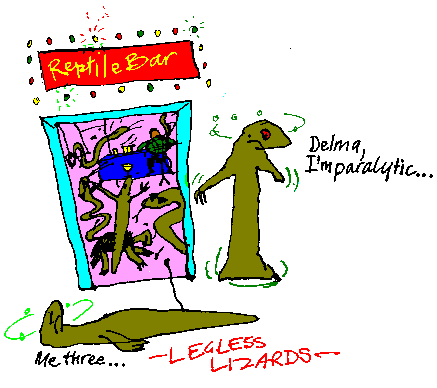 
In both of the above cases, the planning authorities were, or have been made, aware of the occurrence of rare fauna or flora. Although the final outcomes are as yet unknown, it would seem that, for the lizards at least, their survival into the future, is assured. The future actions of the Maclean Shire will be closely monitored by the interested parties for it is hoped that a rare and endangered plant in our area will be accorded the same status as that given to the Legless Lizard in the ACT.
And finally, a special plea. Planning authorities are only made aware of the existence of rare fauna and flora is someone tells them. Public pressure nowadays, generally ensures that such knowledge must be taken into consideration in planning for the future. While an EIS is supposed to investigate and assess the nature of the fauna and flora in a given area, these surveys are sometimes viewed with scepticism. So, please inform the NPWS and/or ROTAP of the existence of any unusual (or even not so) bird, plant or animal, so that these can be added to a database and accessed when necessary.
From the July 1995 issue of the newsletter of the Far North Coast Group (New South Wales) of SGAP. Cartoon by Tim Roberts.
[ Return to Index ]

A plant of geographical oddity
Hakea trineura is one of the most colourful of the eastern Australian hakeas but few people know about it.
Norm McCarthy presents the facts (and nothing but the facts.....).
Hakea trineura is a tall shrub or small tree which grows to a height of about 7 m x 2 m in diameter. It is a plant of geographical oddity.
The species only occurs in two widely spaced situations, 1200 km apart. Whilst apparently identical, except for their flower colour (one red, the other yellow green), their rare and isolated incidence is a botanical mystery. Both colour variants occur in similar terrain, ie open forest country on gravel ridges adjacent to coastal areas. The yellow green flowering form is found near Rockhampton, Queensland at latitude 23 degrees 23minutes. In contrast to this the red flowering form grows near Port Macquarie, New South Wales at latitude 31degrees 27minutes. The mean average rainfall at Rockhampton is 1500 mm while that at Port Macquarie is 843 mm.
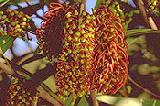 |
The flowers of Hakea trineura tend to be held within the foliage but are still readily visible. Select the thumbnail image or plant name for a higher resolution image (35k).
|
The Toowoomba Experience
In 1989 seed was obtained from both forms and successfully grown. Both forms flowered in September 1996, seven years later.
The green flowered form, growing in part shade, is tall and has yielded 20 flowers. However, the red flowered form has grown more robustly in full sunlight. This plant has reached 2.5 m x 2 m and flowered copiously in almost unbelievable quantities. Flowers are borne in pendulous axillary racemes on old wood within the foliage. Fruit set was poor, several immature seed capsules just disappeared (this is noted as not unusual at first flowering of some plants). The heavy flowering produced abundant nectar and an overpowering but not unpleasant aroma.
The plant is a photographer’s dream - I have the evidence!
The green flowered form performs equally well in the full sun. Mature specimens in Brisbane and at Maleny (100 km further north) have been seen in good flower with massive seed set.
Hakea trineura assumes a column like pleasant ornamental stature. The leaves are thick, lanceolate, about 10 to 16 cm long and prominently 3 veined. The fruit is ellipsoid, curved and smooth (about 3 cm x 2 cm) and may be produced in large clusters. The plant is adaptable to well drained soils, is moderately frost tolerant and prefers a sunny position. It is an excellent large shrub for Hakea enthusiasts and larger gardens. Much quicker results could be obtained by the grafting of mature species onto possibly Hakea salicifolia (saligna) rootstock.
Footnote
An interesting comment below the description of this plant in ‘Flora of NSW’ by Gwen Harden states:
‘There is some doubt as to whether the widely disjunct population in Qld and NSW are the same species.’
From the October 1997 issue of "Native Plants for New South Wales", the newsletter of the New South Wales Region of SGAP.
[ Return to Index ]

Growing Grass Trees
Grass trees form a very distinctive part of the Australian landscape. Morrie Duggan has some advice on ways to get the best out of them in the garden
Many gardeners are probably put off growing grass trees (Xanthorrhoea species) in their garden - either by their reputation for very slow growth, or by the rather sad and pathetic specimens sometimes offered for sale at an exorbitant price in nurseries.
The latter is a fact of life and unlikely to change, but the reputation for very slow growth is somewhat undeserved. In fact, given the right species and the right conditions, beautiful specimen plants can be grown from seedlings in a relatively short time.
I planted a group of five Xanthorrhoea glauca spp angustifolia (grown from seed collected in the Coonabarabran area of New South Wales) in 1988 in a newly constructed raised garden bed about 20cm of very sandy loam and compost over, and partly admixed into, pre-existing silt and clay-rich soil.
Accompanying plantings included various Acacia species (A.penninervis, A. subulata, A.ixiophylla), Pittosporum phillyreoides, Melia azedarach and Melaleuca incana.
Some supplementary water was provided by drippers in the first couple of years after planting, but, since then, the bed has been watered only occasionally during very long dry summer periods.
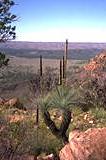 |
The spectacular flowering spikes of a Xanthorrhoea species at Wilpena Pound in South Australia's Flinders Ranges. Select the thumbnail image or plant name for a higher resolution image (38k).
|
No fertilisers have ever been applied. Growth of the xanthorrhoeas was slow for the first year or so, but they seemed to respond favourably to partial shade and frost protection offered by the growing acacias.
Within three years, the plants had grown sufficiently for the group to be an attractive garden feature and now, seven years after planting, all five plants continue to grow strongly.
They each have a fine arching crown reaching over a metre high and 1.5m across, and the rudiments of a trunk beginning to develop at the base.
They are the unrivalled stars of the garden.
I am at present experimenting with seedlings of two other species, X.johnsonii and X.semiplana.
Watch this space!
From the December 1995 issue of the newsletter of the Canberra Region of SGAP.
[ Return to Index ]

[Front Page] [Features] [Departments] [SGAP Home Page] [Subscribe]
Australian Plants online - December 1997
The Society for Growing Australian Plants
|